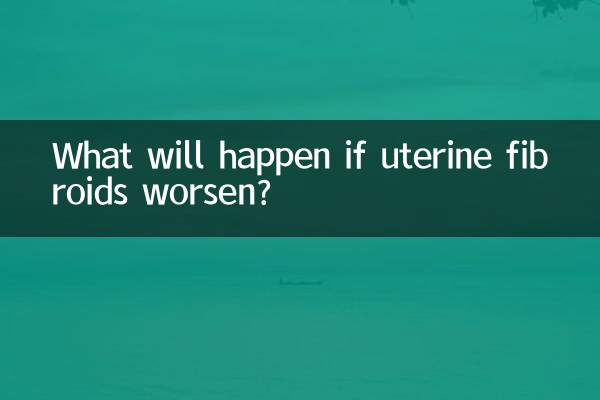What will happen if uterine fibroids worsen?
Uterine fibroids are one of the most common benign tumors in the female reproductive system and in most cases do not pose a serious threat to health. However, if fibroids worsen or develop complications, they can cause a range of health problems. This article will combine the hot topics and hot content in the past 10 days to discuss the possible consequences and countermeasures of the worsening of uterine fibroids.
1. Common symptoms of worsening uterine fibroids

Worsening of uterine fibroids usually manifests itself as a worsening of symptoms or new discomfort. The following are common exacerbation symptoms:
| Symptoms | Description |
|---|---|
| abnormal bleeding | Increased menstrual flow, prolonged menstruation, or irregular bleeding may lead to anemia. |
| severe pain | Worsening of lower abdominal or pelvic pain that may radiate to the waist or legs. |
| symptoms of oppression | Fibroids enlarge and press on the bladder or rectum, causing frequent urination, constipation, or difficulty urinating. |
| Infertility or miscarriage | The location of fibroids affects embryo implantation and increases the risk of miscarriage. |
2. Potential risk of worsening of uterine fibroids
If uterine fibroids worsen without timely intervention, the following health risks may arise:
| Risk type | specific impact |
|---|---|
| anemia | Long-term heavy bleeding can lead to a drop in hemoglobin and symptoms such as fatigue and dizziness. |
| infection | Necrosis or torsion of fibroids may cause pelvic infection, which requires antibiotic treatment. |
| malignant transformation | In rare cases, fibroids may become malignant and become sarcomas, requiring surgical removal. |
| Impaired organ function | Compression of the ureter may lead to hydronephrosis, which requires emergency treatment. |
3. How to deal with the worsening of uterine fibroids
If you suspect that uterine fibroids are getting worse, you should seek medical treatment promptly and take the following measures:
| Countermeasures | Specific operations |
|---|---|
| medical examination | The nature and extent of fibroids can be determined through B-ultrasound, MRI or biopsy. |
| drug treatment | Hormone drugs are used to shrink fibroids or relieve symptoms. |
| surgical treatment | Myomectomy or hysterectomy, chosen based on age and fertility needs. |
| lifestyle adjustments | Avoid high-estrogen foods, maintain a regular schedule, and exercise moderately. |
4. Recent hot topics: New progress in the treatment of uterine fibroids
In the past 10 days, new methods for treating uterine fibroids have become the focus of heated discussion:
| new treatment | Features |
|---|---|
| Focused Ultrasound (HIFU) | Non-invasive treatment that uses ultrasound to ablate fibroid tissue. |
| minimally invasive intervention | Uterine artery embolization (UAE) blocks the blood supply to the fibroid and causes it to shrink. |
| gene targeted drugs | In the clinical trial phase, it is expected to reduce the recurrence rate. |
5. Summary
Exacerbation of uterine fibroids, although uncommon, can have significant health consequences. Risks can be effectively controlled through regular physical examinations, timely treatment and health management. Recent advances in medical technology have also given patients more options. If you have relevant symptoms, be sure to seek medical advice as soon as possible to avoid delaying the condition.
The content of this article is based on the hot spots on the Internet in the past 10 days and is intended to provide scientific reference. Please follow your doctor's advice for specific diagnosis and treatment.

check the details

check the details